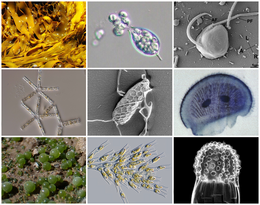| Stramenopiles Temporal range: Late Mesoproterozoic-present,
| |
|---|---|
 | |
| Diversity of stramenopiles | |
| Scientific classification | |
| Domain: | Eukaryota |
| Clade: | Diaphoretickes |
| Clade: | SAR |
| Clade: | Stramenopiles Patterson 1989[2] emend. Adl et al. 2005[3] |
| Phyla and subphyla[4] | |
| Diversity | |
| >100000 species[1] | |
| Synonyms | |
| |
The Stramenopiles, also called Heterokonts, are a clade of organisms distinguished by the presence of stiff tripartite external hairs. In most species, the hairs are attached to flagella, in some they are attached to other areas of the cellular surface, and in some they have been secondarily lost (in which case relatedness to stramenopile ancestors is evident from other shared cytological features or from genetic similarity). Stramenopiles represent one of the three major clades in the SAR supergroup, along with Alveolata and Rhizaria.
Stramenopiles are eukaryotes; most are single-celled, but some are multicellular including some large seaweeds, the brown algae. The group includes a variety of algal protists, heterotrophic flagellates, opalines and closely related proteromonad flagellates (all endobionts in other organisms); the actinophryid heliozoa, and oomycetes. The tripartite hairs characteristic of the group have been lost in some of the included taxa – for example in most diatoms.
Many stramenopiles are unicellular flagellates, and most others produce flagellated cells at some point in their lifecycles, for instance as gametes or zoospores. Most flagellated heterokonts have two flagella; the anterior flagellum has one or two rows of stiff hairs or mastigonemes, and the posterior flagellum is without such embellishments, being smooth, usually shorter, or in a few cases not projecting from the cell.
The term 'heterokont' is used both as an adjective – indicating that a cell has two dissimilar flagella, and as the name of a taxon. The groups included in that taxon have however varied widely, creating the 'heterokont problem', now resolved by the definition of the stramenopiles.
- ^ a b H.S. Yoon; R.A. Andersen; S.M. Boo; D. Bhattacharya (17 February 2009). "Stramnenopiles". Encyclopedia of Microbiology (Third Edition): 721–731. doi:10.1016/B978-012373944-5.00253-4. Retrieved 2 March 2024.
- ^ Patterson, D.J. (1989). "Stramenopiles: Chromophytes from a protistan perspective". In Green, J.C.; Leadbeater, B.S.C.; Diver, W.L. (eds.). The chromophyte algae: Problems and perspectives. Clarendon Press. ISBN 978-0198577133.
- ^ Cite error: The named reference
Adl 2005was invoked but never defined (see the help page). - ^ Cite error: The named reference
8phylawas invoked but never defined (see the help page). - ^ Vørs, N. (1993). "Marine heterotrophic amoebae, flagellates and heliozoa from Belize (Central America) and Tenerife". Journal of Eukaryotic Microbiology. 40 (3): 272–287. doi:10.1111/j.1550-7408.1993.tb04917.x. S2CID 221852241.
- ^ David, J.C. (2002). "A preliminary catalogue of the names of fungi above the rank of order". Constancea. 83: 1–30.
- ^ Cavalier-Smith, T. (1999). "The kingdom Chromista, origin and systematics". In Round, F.E.; Chapman, D.J. (eds.). Progress in Phycological Research. Vol. 4. Elsevier. pp. 309–347. ISBN 978-0-948737-00-8.
- ^ van den Hoek, C.; Mann, D.G.; Jahns, H.M. (1995). Algae An Introduction to Phycology. Cambridge University Press. ISBN 978-0-521-30419-1.
- ^ Alexopoulos, C.J.; Mims, C.W.; Blackwell, M. (1996). Introductory Mycology (4th ed.). Wiley. ISBN 978-0471522294.
- ^ Dick, M.W. (2013). Straminipilous Fungi: Systematics of the Peronosporomycetes Including Accounts of the Marine Straminipilous Protists, the Plasmodiophorids and Similar Organisms. Springer. ISBN 978-94-015-9733-3.
- ^ "Stramenipila M.W. Dick (2001)". MycoBank. International Mycological Association.